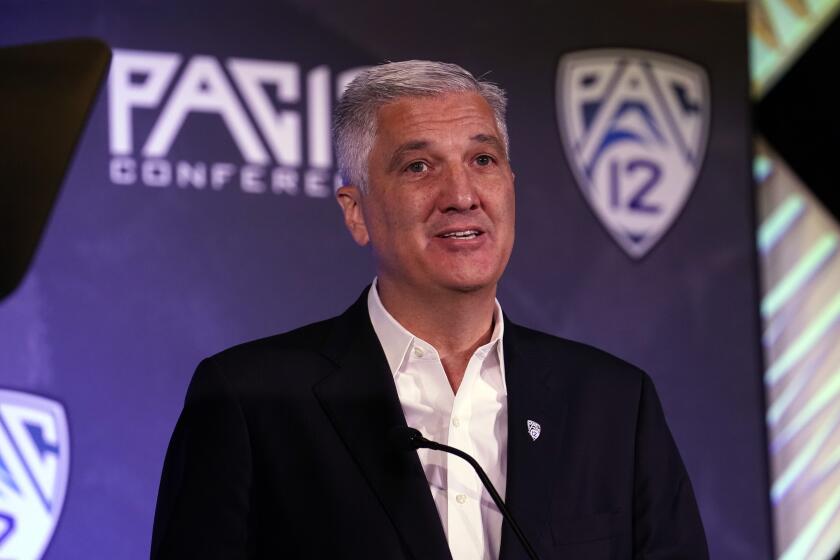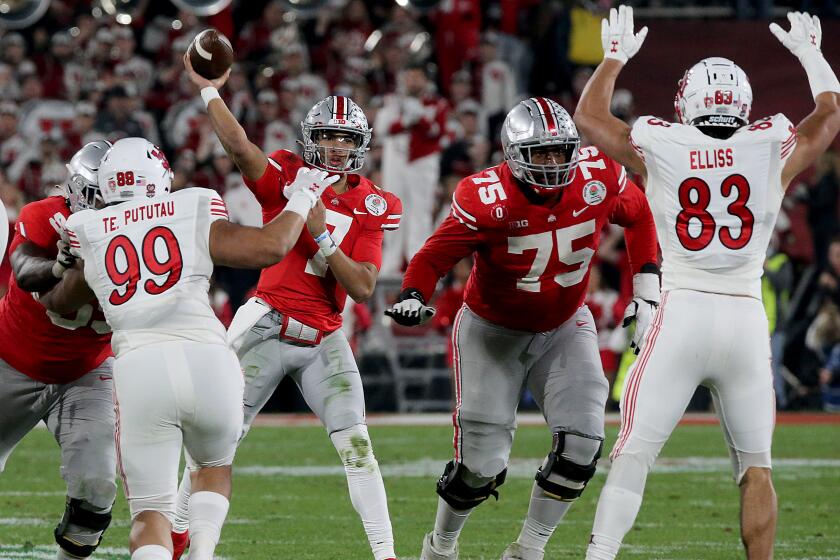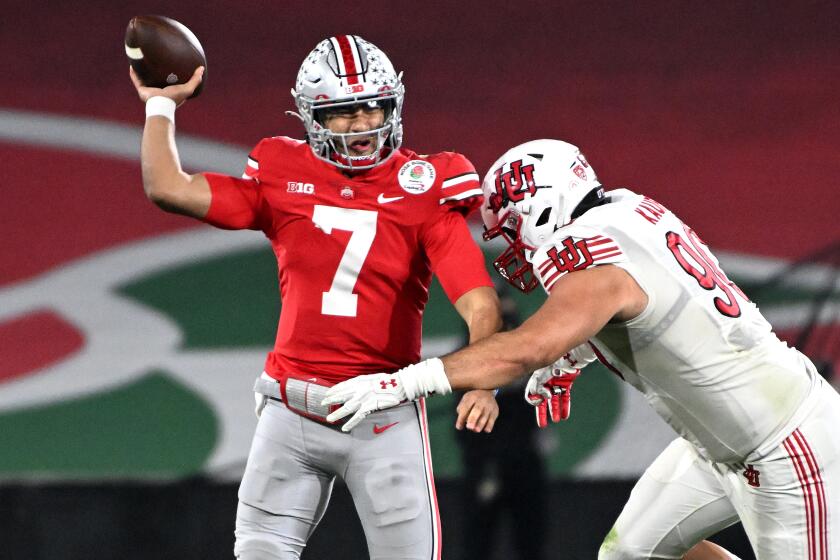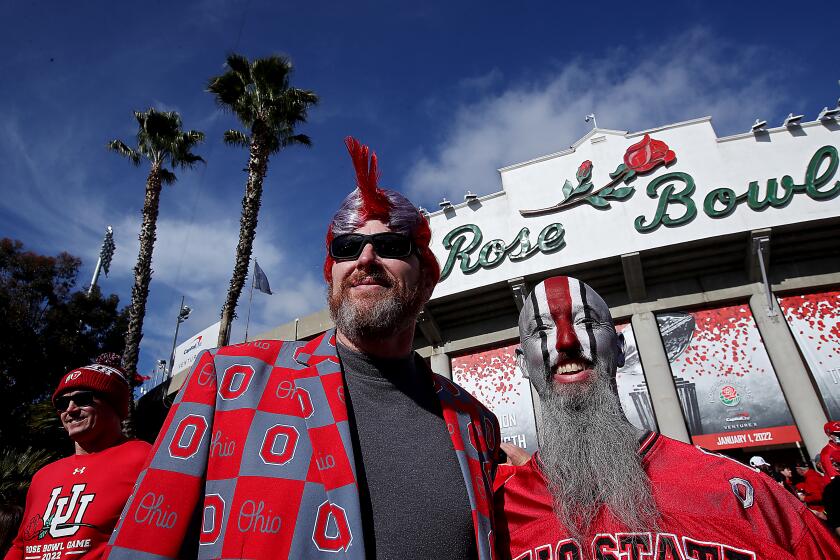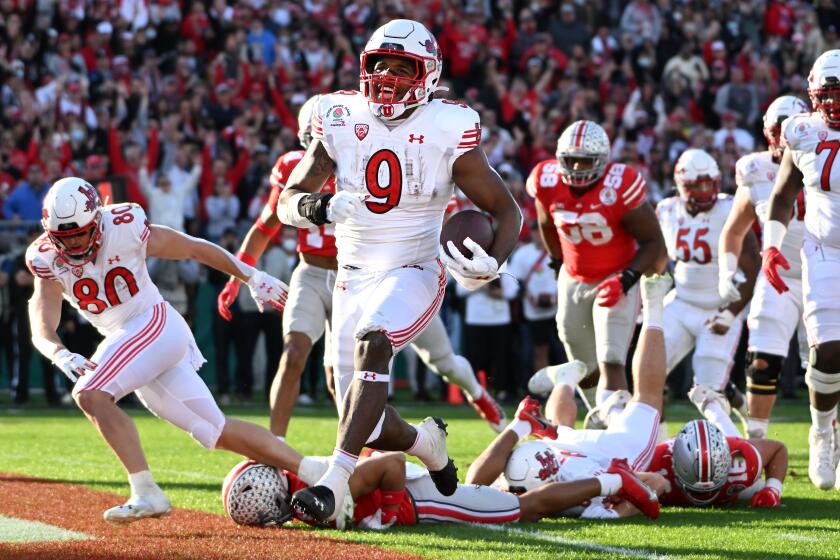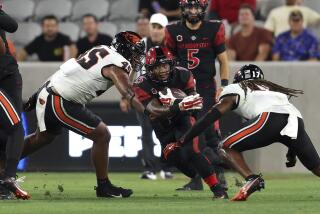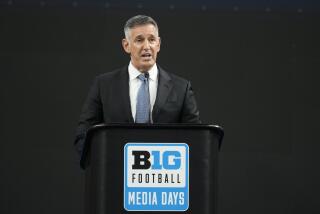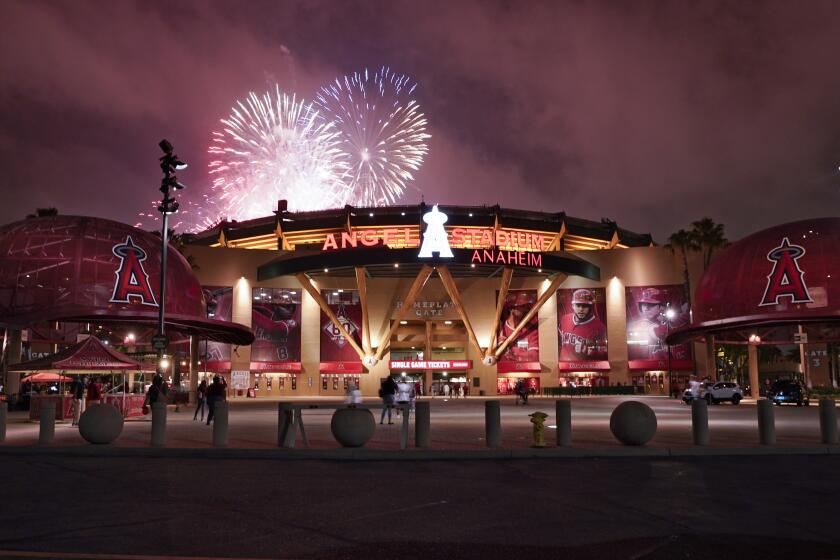George Kliavkoff Q&A: New Pac-12 commish ‘impatient’ with league’s football failures
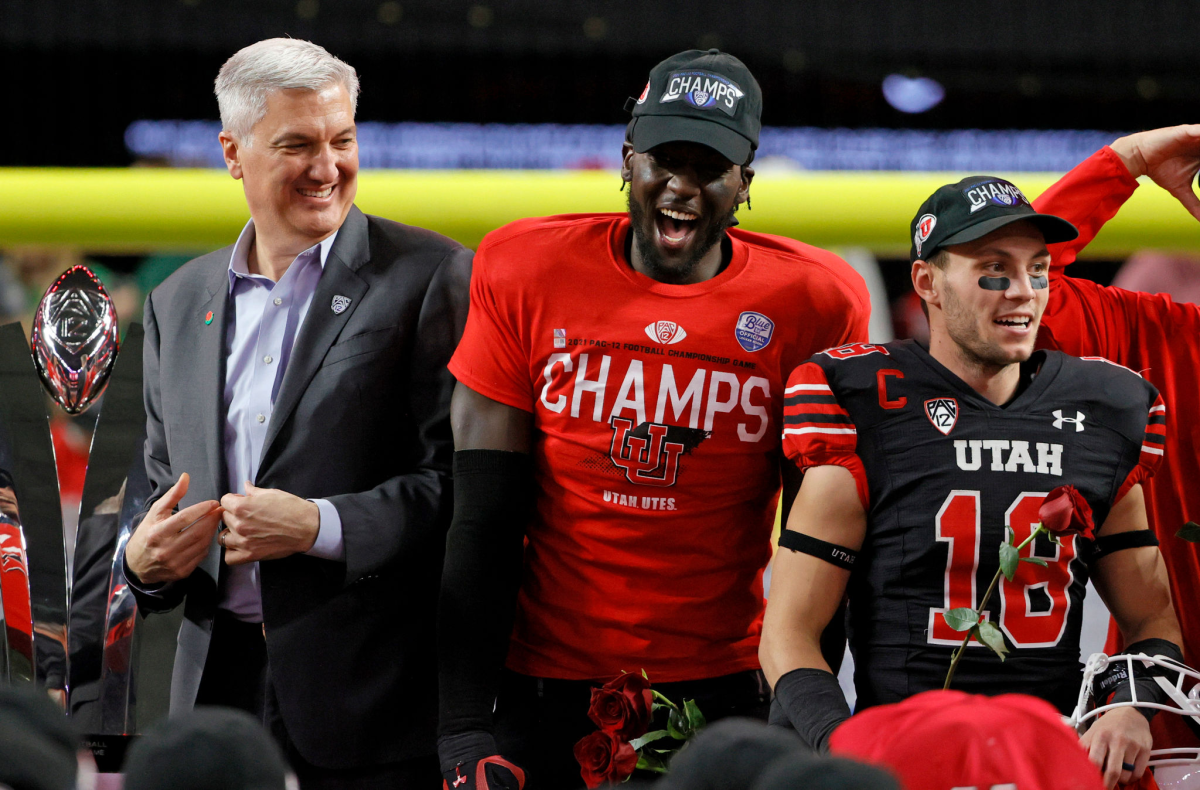
- Share via
I called George Kliavkoff on Sunday afternoon after he had returned from Pasadena to his home in Las Vegas, hoping for a candid postmortem of his first football season as Pac-12 commissioner. I asked the first question, and Kliavkoff did not stop talking for 13 minutes.
“Obviously, this has been weighing heavy on me,” he said with a chuckle.
He had plenty to get off his chest after attending Saturday’s Rose Bowl, where he watched Utah cough up a 14-point halftime lead in a 48-45 loss to Ohio State.
The Utes’ late collapse brought the Pac-12’s bowl record to 0-5 and the league’s mark against other Football Bowl Subdivision teams to an abysmal 9-23.
Our conversation began with Kliavkoff’s fresh take on yet another forgettable Pac-12 football campaign and the systemic flaws he has identified that continue to keep the league a national afterthought. It ended with detailed discussion of the drama of College Football Playoff expansion, how the Rose Bowl can maintain its venerable place in the sport within its new format and USC’s hiring of Lincoln Riley.
With a history of innovation and elite problem-solving skills, commissioner George Kliavkoff says it will be fun helping the Pac-12 navigate massive changes.
You have made it very clear from the get-go that football success was a major priority for you. What have you learned from observing this first season?
George Kliavkoff: Well, I think the learning from the season is that we’ve got a lot of work to do. We evaluated our nonconference performance, and it’s statistically our worst since 1983. Obviously, that wasn’t helped at all by the unfortunate results in all of our bowl games. For me, that just means we have lots of work ahead of us, and it starts tomorrow. I’m looking forward to digging in.
I think there are some overarching issues that are kind of beyond our control that contributed, and I don’t mean this as an excuse for the on-field performance. But I do think we operate in some of the most restrictive states when it comes to Covid protocols, and I think that that had a significant negative effect on the field last year, and I think there was certainly a hangover and carryover this year from that. Early in the season, we had some teams that had played a couple of games in 20 months that were competing against teams that had full seasons the previous April, and I think our guys had less repetitions both in practice and real-game situations than most of their competitors. Hopefully, we’re coming out of that and that won’t be an issue going forward. I also think, if we look statistically at underlying youth and high school football participation rates over the last decade or so, those have dropped more significantly on the West Coast than they have in the Southeast or the Midwest or almost anywhere else in the country, and those are our primary recruiting territories. That’s a long-term issue that we have to deal with and figure out how to work around.
Ohio State’s exciting comeback victory over Utah in a gutsy Rose Bowl thriller showed that college football players do indeed put the game first.
I think we also have some self-inflicted wounds that we have to recover from. One of those is we’ve got to fix our media rights deals, and that has an element related to the amount of money that we have to distribute to every school, but it also has elements related to competitive disadvantages as it relates to our control over what teams get to play during what time periods during the day, and it also has some negative impacts on recruiting because of the lack of distribution of the Pac-12 Networks and the inability for some folks to get to see those games, and I think that hurts recruiting, if we’re honest with each other. I have 30 months left on those contracts, and I’m counting every hour. The Pac-12 fans have my commitment that we’re going to fix that. At the most, it’s going to take 30 months. I’m hoping we can start fixing it sooner, although I inherited some extremely restrictive and tightly written contracts that make it difficult to make many improvements prior to the termination of those agreements. We’re already working on those solutions.
I’ve been very public about the fact that the conference has football as one of its priorities, and obviously there’s a component of that related to playoff expansion, which we’re uniquely in favor of. Everyone is in favor of some form of expansion, but we’ve been the most flexible in respect to what form that takes — eight or 12 teams, [conference champions as] automatic qualifiers or not, who gets the automatic qualifiers. … So there’s expansion, but there are other things within our control. Do we play nine or eight conference games? How do we structure divisions? If we have divisions, do they play in our football championship game or is it our two best teams? How do we schedule both conference and nonconference? How do we gain more control over what time of the day some of our teams play? All of those things over the next couple years are within our control, and we’re going to do everything we can to optimize all of those conferencewide decisions for CFP invitations.
We did a similar exercise in men’s basketball years ago, a strategic process to review every decision the conference made, and I think you started to see that pay dividends last year and again this year with three teams in the top 10. We’re going to go through that same process in football.
We have to be better about keeping our four- and five-stars in our footprint at our schools, and we have to be better about recruiting out of territory, particularly in my opinion offensive and defensive linemen. I watched a lot of nonconference games this year, and I think we need bigger, stronger, faster kids on our lines to compete nationally. And that will require some expansion of our current recruiting territories.
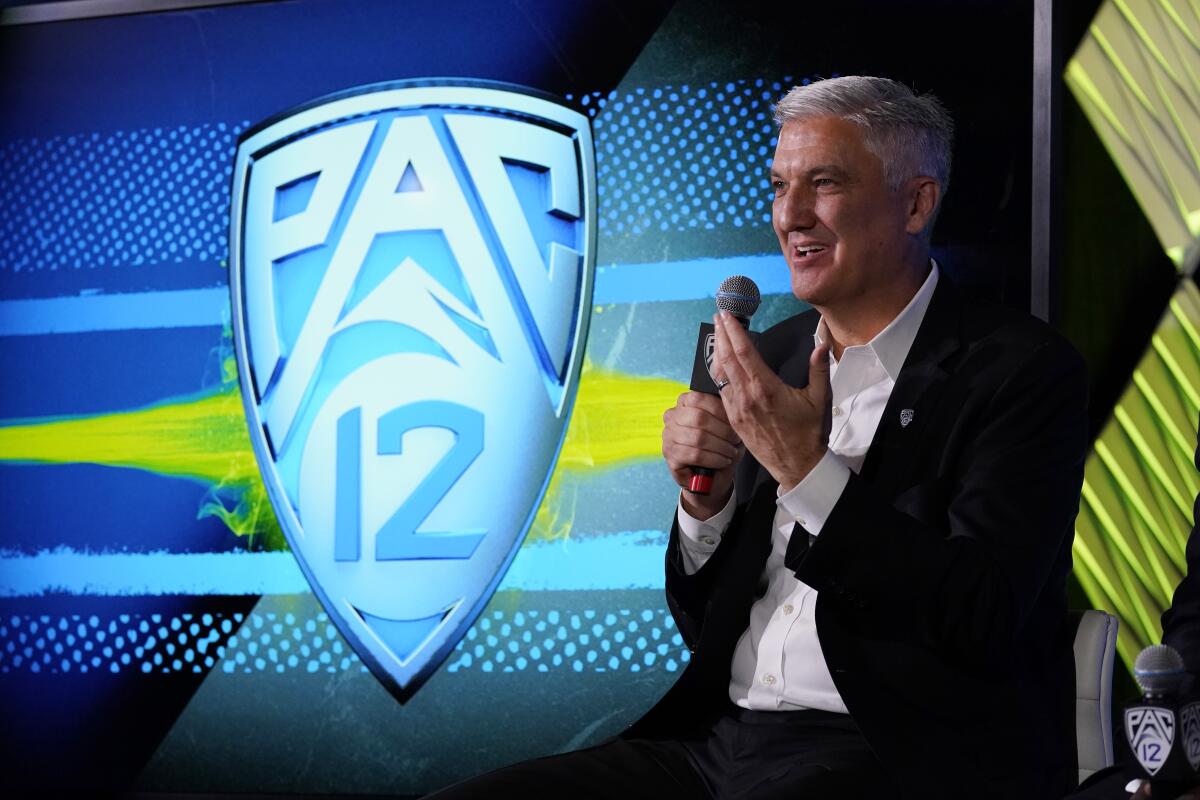
For me, the biggest single issue is an ongoing effort on investing in football. The work of convincing our presidents and chancellors that there is very good return on investment when you invest in football was started by me before I started the job in my press conference when I was announced. I’ve had one board meeting in November, and it was on the agenda, and it will be on the agenda at every board meeting going forward. I think there’s an easy case to make. I don’t think it’s heavy lifting. You invest in football facilities and coaches and other football-related matters and that leads to higher-touted recruits, and that leads to wins, and wins lead to direct and indirect revenue. It certainly leads to significantly increased alumni engagement, and I think historically it leads to increased applications, which results in more selective admissions processes and higher ratings for the schools. The return on the investment in football is just undeniable, and I don’t think we have anyone in our organizations that doesn’t agree with that.
In the last month or so, we’ve seen a bunch of our schools step up facilities and coaching investments that I think are historic for our conference and have already moved the needle in recruiting. I would say continuing that fight of getting our schools to invest is a worthy use of my time.
At the same time, whenever you’re in the Pac-12 and you talk about investing in football or men’s basketball, you get folks who want to remind you that we’re the “Conference of Champions,” and I tend to think that not only are they not mutually exclusive, they’re actually symbiotic. An investment in football and in men’s basketball elevates our opportunity in all sports. They can all be priorities. I think we can walk and chew gum at the same time. (Laughs). We don’t have to make choices between those two.
CJ Stroud, once a star at Rancho Cucamonga High School, passes for a record 573 yards and six touchdowns in Ohio State’s Rose Bowl win over Utah.
I’m excited about the future. I’m as impatient as our fans are, particularly coming off of this season in football. I am doing everything I can — and everyone else at the conference office is doing everything they can — to return Pac-12 football and men’s basketball to the glory that we currently enjoy in almost every other sport.
There is a perception that the Pac-12 presidents and chancellors don’t actually care about winning big in football and that’s a part of how this situation began. How hard is it to get them on board?
Kliavkoff: I think that’s a misconception. Historically, the conference has done very well in football and men’s basketball. But recently — well, it’s [been] 17 years that we haven’t won a championship in either of those sports — other schools in other conferences have accelerated their investment and we haven’t kept up. Part of that is individual school decisions, and part of it is the conference has not put the schools in a position to make those decisions easily because of how long our media rights deals were and as a result we’ve fallen behind a couple of other conferences in our ability to help fund those investments. We are going to fix that, but it’s not an overnight fix. There are some fundamental things we can’t change. I’m focused on the things we can change, but I believe the commitment is there, and the conference has to be better about supporting the schools.
In your preamble you mentioned a lot of areas you are beginning to analyze — anything from scheduling, divisions, structuring the championship game. Are there any areas where you feel close to an answer?
Kliavkoff: We’re not ready to announce anything, but I’ve been public about the fact we’re ready to go from nine conference games to eight immediately. The issue is everybody else is booked. We would not be able to fill those games in if we decided to do that. The fastest path to get there is if the Big Ten decided to do the same thing, and then we could just schedule 12 games against the Big Ten, and we’d be happy to do that for next season. The Big Ten is not ready to make that move yet, and it’s not my place to put them on a timeline to do that. They’re in the middle of their media rights negotiations. The minute the Big Ten is ready to play 12 games against us every year, we’re ready.
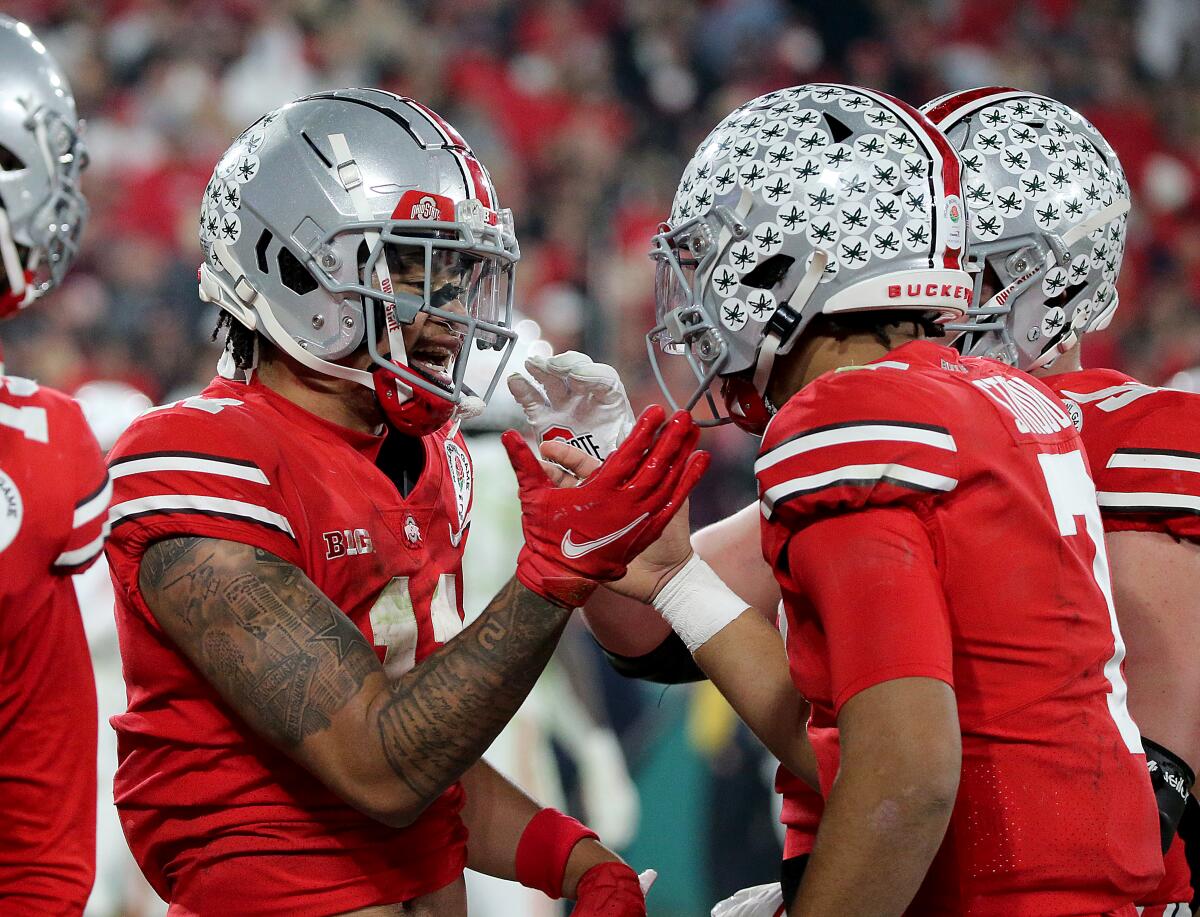
I’ve also been very public about the fact I think it makes no sense that college football is scheduled 10 to 12 years in advance, and I think there will be opportunities there that will be created once some of the conference realignment happens. When the SEC goes from 14 to 16 teams, they will likely have to step up from eight to nine conference games, and we have a lot of out-of-conference games scheduled against the SEC over the next 15 years. Some of those will free up by mutual agreement. I also think when BYU joins the Big 12, they’re going to free up a lot of their schedule too. We have five games against BYU this year in our conference. They will not be able to play five Pac-12 teams every year with a full Big 12 schedule. There are other examples like that. But we have to change the system, and the easiest way to change the system is where we commit to playing eight conference games and one Big Ten team and one ACC team out of conference every year.
If maximizing Pac-12 participation in the playoff is the goal, I assume you’d prefer expansion to 12 teams over eight?
Kliavkoff: We’re extremely flexible. I think the issue that’s been created is it was originally structured as “What do we have to do to amend the current contract within the time frame?” And to do that you have to have unanimous consent by all 11 [FBS conference commissioners]. It’s clear that, despite us being willing to agree to almost anything, with the 10 other folks in the room there’s at least one holdout for every potential scenario that’s been discussed. People have been public about this. The SEC has said we’re not agreeing to any expansion to eight, we’ll only go to 12. If you go to 12, the Group of Five has said we’re not going to agree to the best 12 teams, there have to be automatic qualifiers, and the AQs have to go to the six highest-ranked conference champions. The Big Ten has said we’re OK with going to 12, but it has to be five Power Five conferences get an AQ and the Group of Five gets one additional AQ. The ACC has said it doesn’t think it’s the right time to expand to eight or 12 and is in favor of staying at four.
After a one-year sojourn to Texas, the Rose Bowl returned to Pasadena, hosting fans both eager and emotional to be part of the experience.
So I think the right solution is let’s put aside worrying about what the last two years of the current contract look like and instead let’s think about what the next contract should look like, because we have no obligation to each other after the end of the current contract. If we focus on what the right outcome is going forward, I actually don’t think you need all 11 to agree, certainly contractually you don’t. If enough folks agree then others can make a decision about whether to join the playoffs or not. I think they would choose to join the playoffs, but they don’t have to vote yes to begin with.
How much more lucrative could the next CFP media rights deal be if it’s a totally new negotiation for 2026 and beyond?
Kliavkoff: I think there are a couple of things, right? You go from having three CFP games to having 11 if you go to 12 teams. So obviously there’s just a lot more inventory. I also think there’s an opportunity to have multiple distribution partners, which is not just good for the playoffs but actually allows more companies to be invested in the regular season. And if you want more than one company telling the stories of college football in a deep, passionate way, I think they’re much more likely to do that if they own a piece of the postseason (the NFL does this better than anyone). I think it would be a significant amount of additional money that would be available in a pool, and I want to make sure that we use a good portion of that money to benefit the student-athletes that are creating a lot of the value.
Utah’s strong performance against Ohio State proves Lincoln Riley and USC will have to find a way to overtake Utah and the gains it has made.
What was your takeaway from watching USC let go of Clay Helton so early in the season and have this extremely quiet search that ends with them bringing one of the most coveted coaches in the country to L.A.?
Kliavkoff: I think it was exceptionally well executed by President [Carol] Folt and by Mike Bohn in the way they handled that. I personally don’t love the idea of creating a coaching carousel in the middle of the season, but I think we have rules in place today that make that inevitable, right? You have a system where we’ve moved up the early signing period to be before most of the bowl games, so you have this incentive to have a new coach in place before the end of the season. I think about how tragic it would have been if one game went differently and instead of being No. 5 Notre Dame would have been in the CFP and the coach that got them there had already committed to move. That’s not good for the student-athletes. I don’t blame the coach or his agent for doing that; we’ve created a system where schools had to get coaches in sooner. But, given the current system, I think nobody in the country did a better job of running a process that resulted in a great outcome than USC this year.
Were you shocked when Lincoln Riley was announced?
Kliavkoff: I wasn’t. Mike and I speak often. He had given me an indication of the level of coach that they were looking at, so I didn’t have the surprise that other people had. But it doesn’t mean I’m not pleased. (Laughs). The interesting thing about that investment from USC is I think you’ve already seen other schools in the Pac-12 stepping up their investments. And more importantly, there has been an immediate change to the recruiting dynamic that USC has clearly benefited from and has actually helped and will continue to help other Pac-12 schools. Kids want to play for a guy like Lincoln Riley, and they want to compete against a guy like Lincoln Riley. I think it will elevate everyone for years to come.
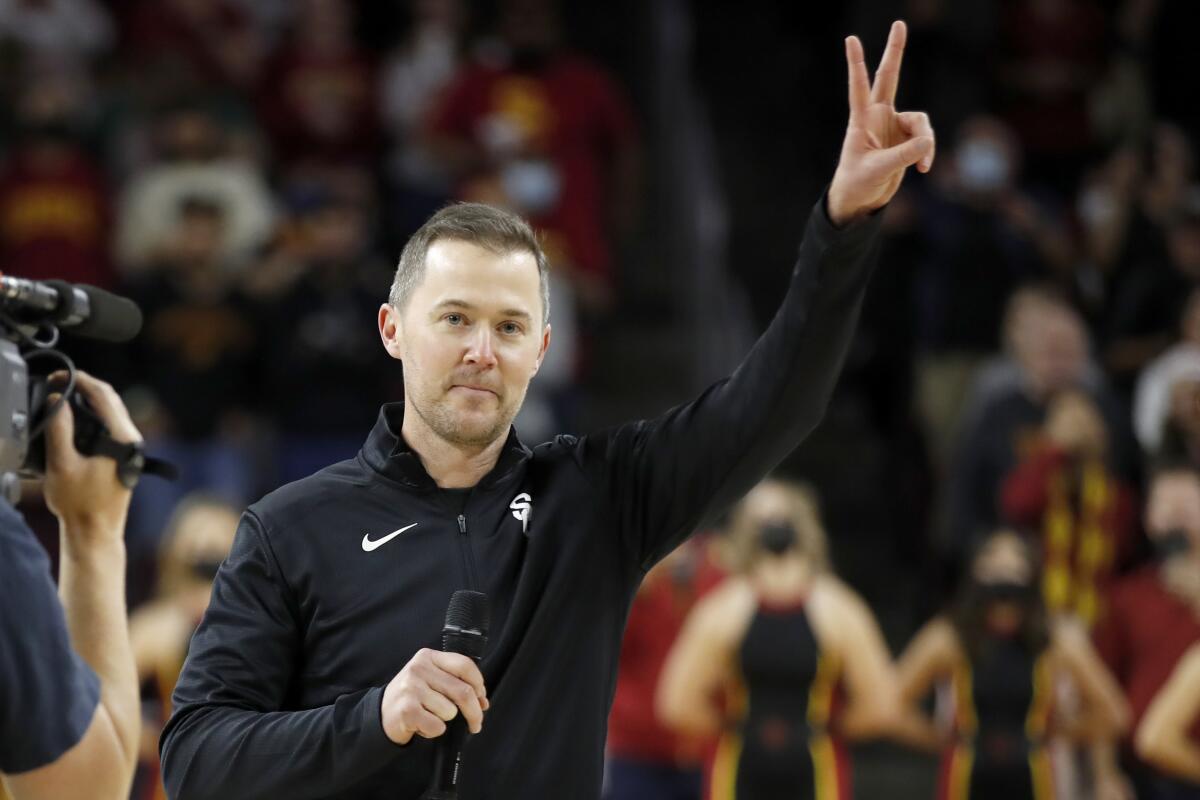
How much of a priority is it for the Pac-12, as the playoff examines expansion, to protect the Rose Bowl’s interests and that traditional relationship?
Kliavkoff: When I think about the Rose Bowl, I don’t think about it in the context of college football. I think about all sporting events in the country. I can’t think of too many that are more important and more of a tradition and kind of a historic touchpoint than the Rose Bowl … 108 years of doing this, people set their clocks to it. It’s a family tradition not just on the West Coast but everywhere. I grew up in New York watching the Rose Bowl every year with my family, sitting on the couch wondering why my parents had us living in New York and not California. (Laughs). I just think it’s one of the iconic sporting events that we look forward to every year. And I can’t imagine the landscape of sports, forget about college football, without the Rose Bowl. And the Rose Bowl has been extremely flexible in trying to fit into the current CFP structure, and they’ve indicated a willingness to continue to be flexible. It’s an iconic and important part of the Pac-12 and Big Ten — and one we’re not going to give up.
But I assume they want to stay on New Year’s Day as always. How does that work if the game is a playoff quarterfinal that potentially falls well before New Year’s?
Kliavkoff: I put forward a proposal that would protect the integrity of all six of the New Year’s Six bowl games and allow them to stay in their traditional time slots. The proposal is very simple, irrespective of if we expand to eight or 12 teams. The four quarterfinal games are intended to be played on New Year’s weekend, and my proposal was: Instead of having the six NY6 bowl games share the four quarterfinal and two semifinal games every year (meaning that four of them on a rotating basis would be quarterfinals and two of them would move off their traditional times to play a week or two later and be a semifinal) what we would do is rotate four quarterfinal games amongst the NY6. Then there’s one year out of three where each of those bowl games is not hosting a quarterfinal, and it would be its traditional bowl game. For the Rose Bowl, all of those games would be played at 2 p.m. on Jan. 1st, and all of the other five bowls would follow a similar pattern. Then, instead of just having the final be a neutral site game, you would have both the semifinals and the final would be at a neutral site, and that would actually create more inventory for college football. You’d have two additional neutral site games every year, and you would have lots of cities lining up to be the host.
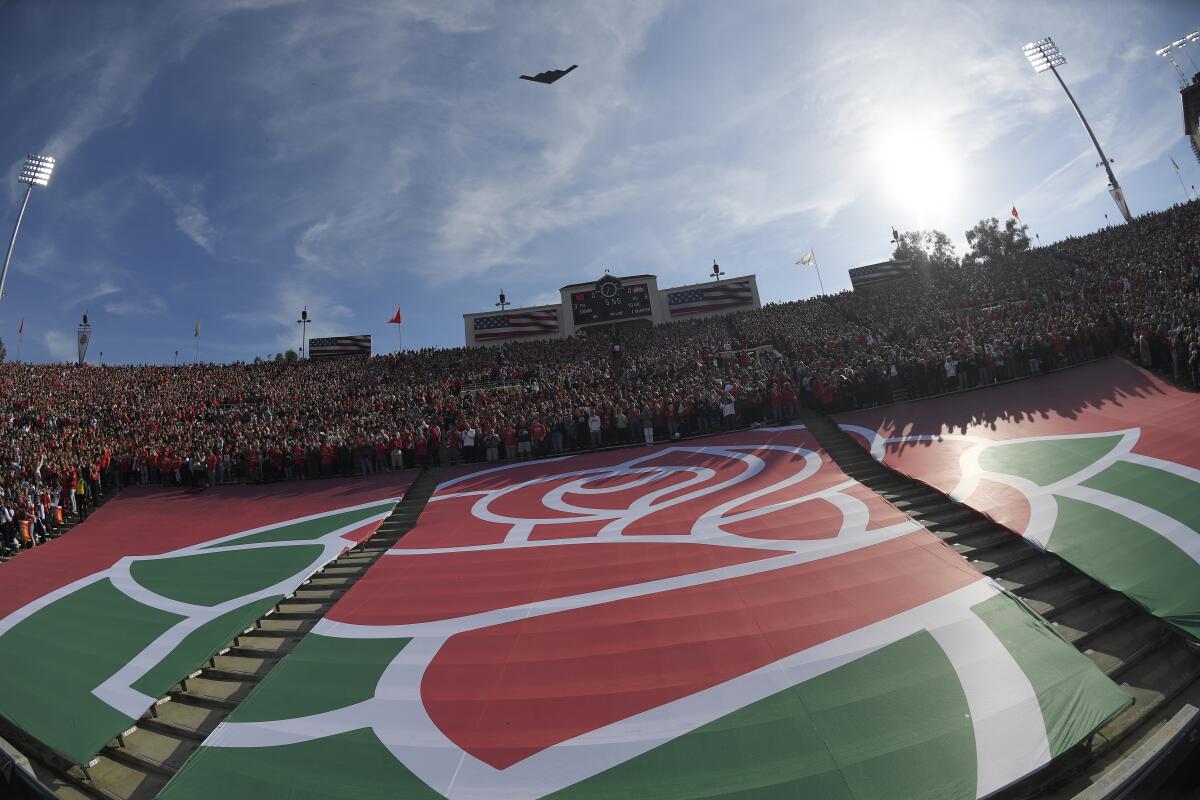
Just to clarify for readers, your proposal has four of the New Year’s Six bowls hosting quarterfinals each year around New Year’s at their usual times. The two bowls that are out of the rotation play with schools from their traditional conference tie-ins at their usual times. The semifinals and final are at neutral sites with no bowl affiliation. OK. And how has that proposal been received?
Kliavkoff: It’s still a part of the ongoing discussion. I think our bigger issue is the format. All the other issues, which are legitimate — student health, academic calendar, participation of the bowls, multiple media partners — we have come up with solutions for everything. We just have to figure out the format.
I can definitely now see why no agreement was reached this fall, which had been the expectation.
Kliavkoff: Well listen, my issue with how this has been handled was not that only four of the 11 folks in that room were working up the proposal over two years. My issue is never in the history of college athletics, when something requires unanimous approval, was the solution announced to the public before that approval was achieved. My issue was with the decision in June — on the same day the Pac-12 and six other conferences saw the proposal for the first time — announce it to the public and position it as “this is sort of a done deal, we just need to rubber stamp it.” I think we did the fans a disservice. I think we created unneeded media columns of speculation about who mistrusts who. I think that did harm to the collegiality in the room that would have been there in greater proportion if this wasn’t being done in public. My strong preference is let’s stop talking about it, let’s get in a room and come to a conclusion and let’s announce it when enough folks have agreed to it. (Laughs).
More to Read
Go beyond the scoreboard
Get the latest on L.A.'s teams in the daily Sports Report newsletter.
You may occasionally receive promotional content from the Los Angeles Times.

